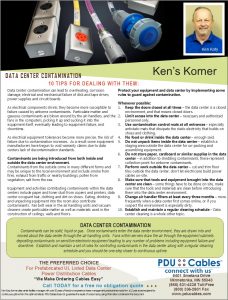KEN'S KORNER - Data Center Contamination
10 Tips for Dealing with Data Center Contamination
[caption id="attachment_633" align="alignright" width="171"] Click here to view, print and share a pdf of this article.[/caption]
Click here to view, print and share a pdf of this article.[/caption]
Data Center contamination can lead to overheating, corrosion damage, electrical and mechanical failure of disk and tape drives, power supplies and circuit boards. Data Center Contamination - 10 Steps for Dealing with them
As electrical components shrink, they become more susceptible to failure caused by airborne contaminants. Particulate matter and gaseous contaminants are blown around by the air-handlers, and the fans in the computers, picking it up and sucking it into the equipment itself, eventually leading to equipment failure, and downtime.
As electrical equipment tolerances become more precise, the risk of failure due to contamination increases. As a result some equipment manufacturers have begun to void warranty claims due to data centers lack of decontamination standards.
Contaminants are being introduced from both inside and outside the data center environment.
Contaminants from the outside come in many different forms and may be unique to the local environment and include smoke from fires, exhaust from traffic or nearby buildings, pollen from vegetation, salt form the sea.
Equipment and activities contributing contaminants within the data centers include paper and toner dust from copiers and printers, data center occupant hair, clothing and dirt on shoes. Eating, drinking and unpacking equipment into the room also contribute contaminants. Fan belt wear in the air handling units and vacuum cleaners create particulate matter as well as materials used in the construction of ceilings, walls and floors.
Protect your equipment and data center by implementing some rules to guard against contamination.
Whenever possible:
- Keep the doors closed at all times – the data center is a closed environment, and that means closed doors.
- Limit access into the data center – necessary and authorized personnel only.
- Use contamination control mats at all entrances – especially anti-static mats that dissipate the static electricity that builds on shoes and clothing.
- No food or drink inside the data center – enough said.
- Do not unpack items inside the data center – establish a staging area outside the data center for un-packing and assembling equipment.
- Do not store paper, cardboard or similar supplies in the data center – in addition to shedding contaminants, these represent collection point for airborne contaminants.
- Perform work outside the data center – cut and trim floor tiles outside the data center, don’t let electricians build power cables on-site.
- Make sure that tools and equipment brought into the data center are clean – some things have to be done on-site, make sure that the tools and materials are clean before introducing them into the data center environment.
- Change air handler filters at least every three months – more frequently when a data center first comes online, or if you suspect the environment is especially dirty.
- Establish and maintain a regular cleaning schedule – Data center cleaning is a whole other topic.
Conclusion
Contaminants can be solid, liquid or gas. They can originate from within the data center or outside. Once contaminants enter the data center environment, they are drawn into and moved about the data center through the air handling units. Fans within servers draw the air through the equipment cabinets depositing contaminants on sensitive electronic equipment leading to any number of problems including equipment failure and downtime.
Contamination can cause a wide range of equipment problems, including intermittent, premature and permanent failure, overheating and loss of energy efficiency.
Establish and maintain a set of rules for controlling contaminants in the data center along with a regular cleaning schedule and you should be one step closer to continuous uptime.
Ken Koty
